Posted: May 2nd, 2017 | Author: lise | Filed under: Awards, Books, Poetry | Tags: #bocaslitfest, #caribbeanwriters, #literaryfestival, #trinidadwriters, Caribbean, Trinidad | No Comments »
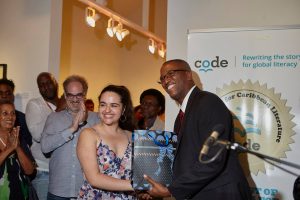
#bocas2017 CODE Org Burt Award ceremony: Puerto Rican writer Viviana Prado-Núñez scooped the first prize for her self-published novel The Art of White Roses. Here she is receiving her award from Chief Justice Ivor Archie, ORTT. Photo courtesy: Marlon James/ NGC Bocas Lit Fest. (Caption taken from the Bocas Facebook page.)
This year’s NGC Bocas Lit Fest was amazing. I mean, I say that every year; the festival is such a boon to the public and the writers of Trinidad and Tobago. This year I had the pleasure and privilege of not only being a prize-winner at the festival, but I got to give a talk to secondary school students about writing; I got to judge a spoken word competition (the First Citizens National Poetry Slam), and to meet and interact with authors from around the world.
There were the regulars, with whom I have communed here and in Jamaica—the Kei Millers, Carolyn Coopers, Eddie Baughs, Monique Roffeys and Philip Nantons—they’re here at Bocas regularly, if not annually. Seeing them in the corridors of the National Library of Port-of-Spain is reassuring and delightful. They bring their grace and talent to us here and I never take them for granted.

Kei Miller giving his acceptance speech after winning the OCM Bocas Prize for Caribbean Literature. Well deserved. Photo: Marlon James/ NGC Bocas Lit Fest
This year I also got to meet new Caribbean writers like Safiya Sinclair, author of the OCM Bocas Prize for Poetry for her new collection Cannibal; and international stars like the gifted essayist Eliot Weinberger, whose essay on the stars made me hold my breath when he read it at the festival. (It’s at the seven-minute mark on the video, or thereabouts.)
https://www.facebook.com/bocaslitfest/videos/1499008553477352/
I had the enormous pleasure of seeing Trinidad Noir: The Classics celebrated in a pre-launch event where its co-editor Earl Lovelace read his indeed classic story “Jobell and America”, and where host elisha efua bartels read from her story “Woman is Boss” from the original Trinidad Noir.
I had the thrilling opportunity to meet the extraordinary young writer from Puerto Rico, Viviana Prado Nunez, whose novel The Art of White Roses won the Young Adult literature prize CODE Burt Award for Caribbean Literature (I came third in the contest with my manuscript Waiting for the Bus, and my fellow Trini Kevin Jared Hosein came second with his dark tale The Beast of Kukuyo). And the pleasure of hearing Kenyan journalist and fiction writer Peter Kimani, author of the new international hit novel Dance of the Jakaranda, read—and sing!—from this glorious, textured work.
https://www.facebook.com/bocaslitfest/videos/1498946876816853/
One of the unexpected highlights for me was judging the Slam. (I was a last-minute replacement for a judge who was unable to make it to the show.) Here were some undeniably talented young people, competing for the mindblowing prize of TT $50,000. They went all out and gave their blood, sweat and tears to the packed audience at NAPA. Happily, the audience agreed with the judges’ decision! (Head judge was the dazzling poet Anthony Joseph, with Philip Nanton, Safiya Sinclair, and UWI, St Augustine, head of the MFA programme Muli Amaye and I also on the panel.)

Congratulations to Camryn L. Bruno, winner of the Grand Slam: 2017 First Citizens National Poetry Slam Finals! Here she is, holding her $50,000 cheque, flanked by second and third place finalists Alex Stewart and Idrees Jali Saleem.
Bruno, Stewart, Saleem and their fellow finalists performed to a legion of fans, community members in the arts, and #bocas2017 attendees: the NGC Bocas Lit Fest salutes the #FCNPS2017 competitors for their bravery, talent and dedication to sharing their all on the Caribbean’s largest spoken word stage.
Photo by Marlon James, official Bocas Lit Fest photographer.
(Caption taken from the Bocas Facebook page)
Bocas is a gift. I am thankful.
Posted: April 19th, 2017 | Author: lise | Filed under: Books, Uncategorized | Tags: #bocaslitfest, #caribbeanliterature, #caribbeanwriters, #novels, #popularfiction, #trinidadwriters, #westindianliterature, #womanwriters | No Comments »
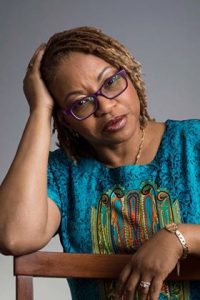
Trinidad-born Nathalie Taghaboni is the author of the Savanoy series: Across From Lapeyrouse, Santimanitay and Side By Side We Stand. She very generously agreed to do a guest post on my blog in anticipation of the 2017 NGC Bocas Lit Fest in Port-of-Spain, which she’s taking part in.
Perhaps if I had to find one word to describe these weeks and days leading up to the 2017 Bocas Lit Fest, I would probably chose “unreal”. Everything, even the very real and necessary planning took on a dreamlike quality.
I think it was back in 2012 when I first heard of Bocas. When I left the country, there was no such thing and I was no author. My first formally published work started in 2001 with a weekly column in a Toronto newspaper called SHARE. I was writing social commentary á la picong with all the Trinidad Nation Language you could shake a stick at. A book was a vague something-something in the back room of my mind. Even after I self-published a collection of those columns, the book idea was only slightly less nebulous.
My first novel started taking shape in my head before I was aware of it. This might sound crazy but I never protest not to be. I wrote the novel, printed a few hundred copies and figured most of them would end up in my basement as a condo for mice. So imagine my surprise when the book that had eschewed the formal writing style, opting for a storytelling style, sold out and demand made it imperative to reprint. The story was good and folks wanted more.
It was after the book was out that I heard about Bocas. I nervously sent in my poorly edited book to the New York judge on the same day that the US east coast was flooded by a storm. He emailed to say the book was destroyed. It took that Act of God for me to become determined. I sent another book to him but never made it to the long list. The story was poorly presented, I knew that, but rather than give up, I dug in my heels and wrote the sequel. A far, far better work.
But a self-publishing stint is expensive and with the second novel, part two in my unexpected series, I simply could not afford to enter the Bocas Lit Fest. I spent the next few years saving and writing until July 2016 when the third and final installment was published. I submitted the book and sat on pins and needles awaiting the list announcement.
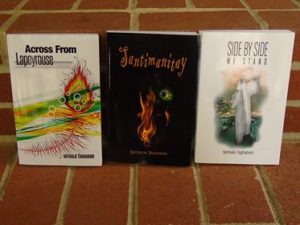
During my wait something else was happening, slowly, surely. All along, folks were reading, supporting, encouraging me and my style of storytelling. I received an invitation to speak on a panel at Bocas.
If you know me at all, you know I am never short for words. The email invitation left me speechless. It cushioned the blow of not making the long list of 2017 Bocas Lit Fest Prize authors.
Yet, this ex-pat, writing all alone in arguably the most culturally bereft state of the Disunited States of Twitler, is coming home with her humble offering to talk with and listen to other Caribbean authors. I am looking forward to the opportunity and honour.
Can’t wait to tell you how it went!
Nathalie Taghaboni will speak on the panel Family Ties (along with Aliyyah Eniath, author of The Yard), April 28, 3- 4 pm, Old Fire Station, during the Bocas Lit Fest.
Posted: October 16th, 2011 | Author: lise | Filed under: Books | Tags: Alice Walker, artists, Brown Girl in the Ring, Caribbean fantasy, Caribbean sci-fi, Midnight Robber, Nalo Hopkinson, Race, role models, speculative fiction, Trinidad & Tobago, UWI, WI Literature Conference, writing | 1 Comment »
Last week I picked up the Alice Walker collection of essays In Search of Our Mothers’ Gardens and reread the very first essay, “Saving the life that is your own: The importance of models in the artist’s life”. I’ve read this essay before, many times, in fact, over the years since I first got the book back when my teenager was a little baby. The essay’s theme, that artists need to have templates to follow in order to live their lives, is one that I have always believed in. The templates are knowledge of the very existence of other artists like them. The timing of my rereading of the essay proved prescient, as this weekend I was fortunate to meet a woman writer whom I have admired for years, Nalo Hopkinson.

Nalo Hopkinson. Photo from http://nalohopkinson.com/
A brilliant writer, Nalo is one of the few Caribbean sci-fi/fantasy writers who have been internationally published. Her first books Brown Girl in the Ring and Midnight Robber are bonafide sci-fi classics. She writes brave feminist fiction; it is outstanding not simply because of its themes and Caribbean characters of colour (and the fact that in speculative fiction black writers are few and far between) but also because she’s a fine writer with a gift for lush, descriptive writing.
I treasured the time I spent listening to her and in the writing workshop she gave at the 30th WI Literature Conference, which took place at UWI, St Augustine, this weekend. Here is a writer who more or less forged her way in the publishing world without compromising her vision or her voice. This is a model I would be happy to emulate.
Posted: September 3rd, 2011 | Author: lise | Filed under: Books, Column | Tags: Caribbean, Caribbean Beat, Caribbean writing, How to Escape from a Leper Colony, interviews, OCM Bocas Prize, Tiphanie Yanique, Trinidad Noir, USVI, writing | No Comments »
The latest issue of Caribbean Beat magazine features an interview I did with USVI writer Tiphanie Yanique. You can read it here. I’ve already written a bit about Tiphanie on this blog here, but it’s worth repeating that she’s a gifted writer and I’ve been privileged to do a little book tour with her in NY a few years ago. I know she’s going to be an even bigger name in Caribbean literature as the years roll on and I’m pleased to have my name next to hers in Trinidad Noir, to which she contributed a story that appears in another version in her prize-winning book How to Escape from a Leper Colony. Write on, Tiphanie!
Posted: June 1st, 2011 | Author: lise | Filed under: Books, Column, The Allen Prize | Tags: African-American, black, Caribbean, Harlequin, Kimani, Mills and Boon, Race, romance, Roslyn Carrington, Simona Taylor, Trinidad & Tobago, Trinidad and Tobago, writing | 3 Comments »

The cover of Intimate Exposure by Simona Taylor
Possibly because my mom was an avid Mills and Boon reader, I was weaned on romance novels. I loved these books for their ability to translate dreams and fantasies about love and happiness into 200-page packages in which the girl always got her man AND the amazing career she wanted, a perfect house and babies, to boot. A bonus was the settings–I learned about Australia, Canada, England, Scotland, Ireland, Kenya, Fiji, the Seychelles, all through the writings of such romance stars as Barbara Cartland, Penny Jordan and Margaret Way. Later, I learned about the US through the Desire brand and Harlequin Romances. All the characters were white and the men were rich and the women mostly middle class. Somewhere along the line I discovered that the characters didn’t have to be white; there were black–even Caribbean–romances, too. Trinidadian author Valerie Belgrave has written some, including one called Tigress, which I planned, once, to write a thesis on.
Another Trinidadian author, Roslyn Carrington, has made a career writing black romances under the pen name Simona Taylor. (Full disclosure: Roslyn has been a speaker and a judge for various aspects of my NGO, The Allen Prize for Young Writers.) She gave me a copy of her latest, Intimate Exposure (Kimani Press, 2011), a couple of weeks ago and I read it hungrily. I found to my delighted surprise that not only was her story intriguing and captivating like a good romance novel ought to be, I liked her characters as well.
Romance novels rely on a formula that is seldom, if ever, deviated from: the male lead is very rich, charming and a chick magnet, while the female lead is unspeakably beautiful but for some reason in an awkward spot. They meet and he immediately falls in love with her but tries to deny it (and she does the same for him). After triumphing over some betrayal, they live happily ever after. (Think Pretty Woman, except that Julia Roberts’ character is a secretary, not a whore.) That holds true for Intimate Exposure, but with some surprising twists–which I won’t give away because I don’t want to spoil them for you.
What most impressed me was the writing of the characters as feminist. The woman enjoys sex thoroughly (all the time, not just with this magical man in the book) and has an actual career in which her intelligence and education–not her great fashion sense–are paramount. She rescues herself from the betrayal, albeit with a push from the male lead–hey, it’s still a romance novel, and some things are inviolate here, including the man’s role as leader. She is, in short, a three-dimensional, smart, self-motivated woman. The male lead is allowed to cry and show weakness, and while he abets her in her struggle, he’s not the one who “saves” her. She saves herself.
The writing is tight and carries the reader along nicely, and there is the requisite stop in an exotic, pastoral destination–in this case the Caribbean island of Martinique; and the sex scenes are spicy and credibly written. In short, it provides all that a romance novel needs to be an entertaining escapist read, and more.
Posted: May 9th, 2011 | Author: lise | Filed under: Books | Tags: Caribbean, Caribbean Beat, Caryl Phillips, Lisa Allen-Agostini, literature, reading, St Kitts, Trinidad & Tobago, Trinidad and Tobago, words, writing | No Comments »
When I first started buying my own books, one of the first I picked up was a screenplay of Caryl Phillips’ Playing Away. The Kittitian-British writer has always had a special place in my heart because of that early memory and it was a pleasure and a privilege to interview him for Caribbean Beat Magazine last year when he was here during the Trinidad and Tobago Film Festival.
Many months later, here’s the story in Caribbean Beat. Hope you enjoy it.
Posted: April 10th, 2011 | Author: lise | Filed under: The Allen Prize | Tags: education, Lisa Allen-Agostini, literature, motivational speaking, seminar, The Allen Prize, training, Trinidad & Tobago, Trinidad and Tobago, words, writing, young people, young writers | No Comments »
I’m tired but happy today because The Allen Prize for Young Writers’ Term II Seminar was held yesterday and it was a success. Tired=lots of planning work and running around, then hosting and stage managing yesterday with the help of lots of people–my brother Dennis, my daughters, Rhoda, Brian. Happy because (although our preregistration drive netted us more than 50 students the actual turnout was, once again, lower than expected) we had a small but keen audience.

Part of the audience.
The speakers were marvelous. Nicholas Laughlin talked about the possibilities of creative non-fiction.

Nicholas Laughlin at The Allen Prize Term II Seminar 2011
Monique Roffey spoke about her life as a writer, starting as a wall-scrawling toddler, up to her short listing for the Orange Prize in 2011.
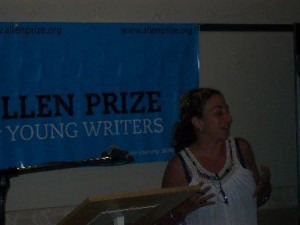
Monique Roffey at The Allen Prize Term II Seminar 2011
And Muhammad Muwakil performed his spoken word magic before giving a talk on writing.

Muhammad Muwakil at The Allen Prize Term II Seminar 2011
Gillian Moor was our guest performer.
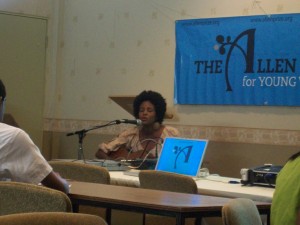
Gillian Moor at The Allen Prize Term II Seminar 2011
It was an exciting morning. Now on to the Awards Ceremony in May, and the next seminar–in Tobago!–in June.
Posted: September 10th, 2010 | Author: lise | Filed under: Books, Column, Editorial | Tags: Editor, Lisa Allen-Agostini, literature, Sci-Fi, Trinidad & Tobago, writing | 3 Comments »
Maybe it’s the weather or the time of year, but I’ve had two requests for writing advice in the past two days. Here, once again, is my best advice.
 When asked what advice I would give to writers, I usually say these two things:
When asked what advice I would give to writers, I usually say these two things:
1. WRITE
2. READ.
The first bit of advice sounds so simple but is so hard to do. WRITE. It means making a conscious effort to write, if not every day, on some regular schedule. Turn off the TV, close the MSN chat window, get off Facebook and write. Life is so full of distractions and responsibilities that it’s not uncommon to hear writers complain that they can’t find time to write. I, too, am guilty of doing it. Even though one of the things you’ll find when you Google my name is this post on discipline in writing, lately I’ve been making plenty excuses for not buckling down to the half-finished manuscript I began last year. Granted, the book is depressing as hell and drags me back into a personal memory I’d rather ignore–it’s a novel about possible consequences of child sexual abuse–but I have made a committment and I need to attend to it. Plus, it’s a really good story. 🙂 I think the world, especially Trinidad & Tobago, needs this story so people stop ignoring a problem that is right under their noses.
But writing is hard work in some ways, especially writing fiction. I have no publisher yet so there’s no deadline to whip me, and it’s my own project so there’s no editor to nag me. I started the book with Wayne Brown as my writing coach and he would give me weekly deadlines to meet, but he has since passed away and my subsequent attempt to work with the brilliant writer Monique Roffey flopped because I just couldn’t write at the time.
When I’m writing it’s great. There are times when the words fly onto the computer screen all by themselves, the characters sing and dance and take lovers and licks as if they were real people and I were just a cameraman recording the action. There are other times when each word is a struggle. Because it’s set in multiple times, I have to keep other windows open with calendars and research about clothes, food, news events and other stuff that fill out the story. And you can imagine that I sometimes get distracted by children, housekeeping (VERY RARELY! Ha!), hustling and the rest of my life. Sleep is the biggest culprit, though. Why write when you can sleep? Sleep usually wins, even though I know those last eight chapters won’t write themselves.
Maybe I should do like Mystie Thongs and blog on the struggle to get back on my (literary) feet. If I had written a page a day over the last year when I didn’t write anything at all, the book would be done and in third revision by now!
My only consolation is that at least I’m taking my own advice on the other thing writers should do: READ.
I am, as my Facebook friend Adrian Charles called it, an obligate bibliovore. I have to read, and I’m usually reading at least one book. In the last couple months I’ve read Sun Dog, by Monique Roffey, Falling Angels, by Tracy Chevalier, and Dog-Heart, by Diana McCaulay, among others.
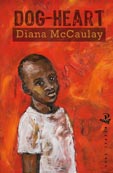 Reading increases your vocabulary, improves your technique and widens your repertoir. I have read hundreds of romance novels and–as much as literary types would turn up their noses at the genre–I owe my relatively good grammar to them, and my vocabulary in part to them, too.
Reading increases your vocabulary, improves your technique and widens your repertoir. I have read hundreds of romance novels and–as much as literary types would turn up their noses at the genre–I owe my relatively good grammar to them, and my vocabulary in part to them, too.
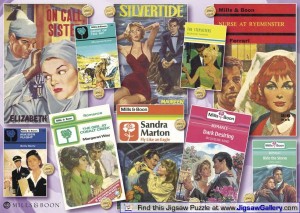
Those long-time Mills & Boon books were great for words like “maelstrom” and “ingenue” and so on, and they were written in the strictest Standard English. I read other things, too… sci-fi, poetry, plays, murder mysteries, text books… and everything I read somehow creeps out into my writing, not in direct ways but you can see threads of them if you know what you’re looking for. Plus, reading is fun!
What do you writers do to keep writing?
Posted: May 22nd, 2009 | Author: lise | Filed under: Books | Tags: Akashic Noir, Anthology, Editor, Noir, Trinidad | 1 Comment »
Named one of the Best Books of 2008 by the Caribbean Review of Books
Trinidad Noir
edited by Lisa Allen-Agostini & Jeanne Mason
Mystery/Fiction Anthology | A Trade Paperback Original
ISBN-13: 978-1-933354-55-2 l 300 pages | $15.95
Published by Akashic Books as part of their award-winning Akashic Noir series, Trinidad Noir brings together the best writers in Trinidad & Tobago and an exciting genre.
Trinidad Noir features new stories by: Robert Antoni, Elizabeth Nunez, Lawrence Scott, Ramabai Espinet, Shani Mootoo, Kevin Baldeosingh, Vahni Capildeo, Willi Chen, Lisa Allen-Agostini, Rian Marie Extavour, Keith Jardim, Jaime Lee Loy, Darby Maloney, Reena Andrea Manickchand, Judith Theodore, Tiphanie Yanique, and others.
Akashic Noir was launched with the best-seller Brooklyn Noir. Each of the titles in the series features original noir stories, each one set in a distinct neighborhood or location within the city of the book.
Trinidad Noir is the first book in the series to be set in the English-speaking Caribbean.
“Trinidad Noir delivers all the crime a reader expects from Akashic’s Noir Series: murder, kidnapping, rape, drugs, prostitution, theft, extortion, and more. Yet in fictionalizing crime in the real crime setting of Trinidad, acclaimed authors Lawrence Scott, Robert Antoni, Elizabeth Nunez, Ramabai Espinet, Keith Jardim, Tiphanie Yanique, Willi Chen, and others have created a decidedly literary noir collection,” says the Akashic Web site. “These authors’ quality characterizations, plots, and styles concurrently reveal the country’s darkness and its appeal with an unexpected and gratifying result: In their captivating and occasionally humorous stories, the Trinidad that emerges is as intriguing and contradictory as the island and its people. Trinidad Noir is as much a delightful crime romp as it is an expose of the seedy side of life.”
Co-editor Jeanne Mason is a freelance editor who also writes short stories and poetry. She has lived in Paris, France, where she edited medical articles for US and UK journals. She currently resides in Trinidad & Tobago.
Posted: May 22nd, 2009 | Author: lise | Filed under: Books | Tags: Chalice Project, Lisa Allen-Agostini, literature, Sci-Fi | No Comments »
New from Macmillan Caribbean!
The Chalice Project
By Lisa Allen-Agostini
ISBN: 9781405098991
Price: £4.44
Extent: 192pp
Binding: Paperback
Publication Date: 03/10/2008
Format: 196 x 129mm
 Twins Ada and Evan Bridgelal live in Trincity, Trinidad, with their father Steven, a scientist. They have never met their mother and are dying to know more about yer but Steven won’t come clean about their history.
Twins Ada and Evan Bridgelal live in Trincity, Trinidad, with their father Steven, a scientist. They have never met their mother and are dying to know more about yer but Steven won’t come clean about their history.
Though they don’t know it, they have a special secret, one only their father can explain. When they enter secondary school and join rugby teams, strange things start happening to them and the mystery thickens.
The Chalice Project is a science fiction, action-adventure story for 10-15-year old readers. They’ll love the characters, the story and the setting. The book is written in bold, bright, descriptive language that engages the imagination and brings the tale to life. It is part of the Island Fiction series by Macmillan Caribbean.















